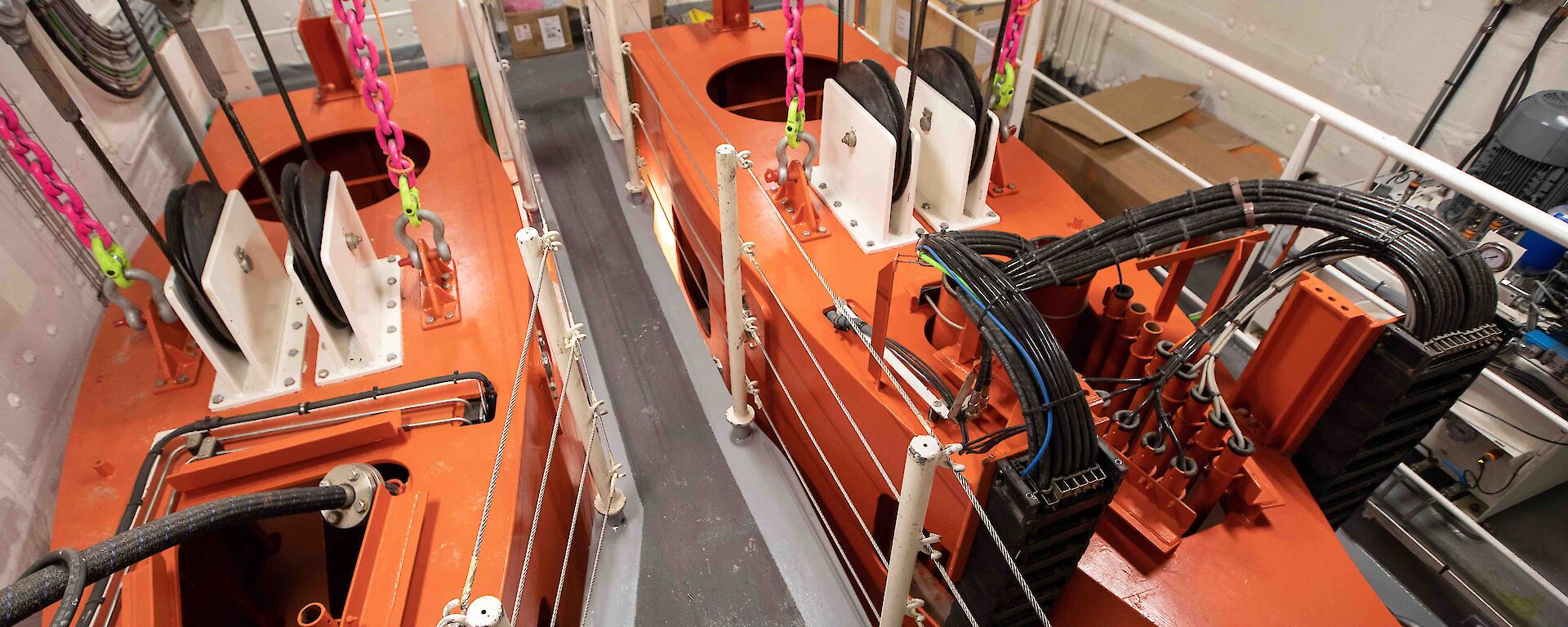A lot of work has gone into the design of the ship’s hull and propulsion system to reduce noise associated with the engines, gear boxes and propellers, as well as bubble formation (which make noise when they pop) and the downward sweep of bubbles which ‘blinds’ the acoustic instruments.
The new icebreaker’s ‘bioacoustic transducers’ can identify when organisms are present and then measure how many of them (their 'biomass') are there. These instruments are mounted in the ship’s hull and drop keels, and listen to the returning echo as pings of sound bounce off objects in the water. If a school of krill is in the area, for example, the echo will appear as a large, bright mass on computer screens. The strength of these returning echoes helps scientists measure the animals' biomass. A team can then drop a net from the back of the ship or through the moon pool, to collect samples from the water.
Other important acoustic instruments are the multibeam echosounders. A large low frequency multibeam is used to map a swath of the seabed up to 25 kilometres wide in one pass, and work at depths up to 11,000 metres. A higher frequency multibeam provides higher resolution measurements on the continental shelves. A third sideways looking multibeam 'sees' schools of fish and krill, to help scientists understand their swirling movements.
Among other things, maps of the seabed generated using multibeam echosounder data:
- provide insights into the geological and glacial history of the area
- allow scientists to identify areas for further study or for trawls for specific organisms
- provide information about volcanic activity
- provide safer navigational charts in areas close to the Antarctic coast, such as around stations.
The ship also has hydrophones to listen for marine mammals, a fisheries sonar that allows scientists to find schools of fish or krill, and Acoustic Doppler Current Profilers, which provide information on the three-dimensional water currents beneath the ship.
For geoscientists, a sub-bottom profiler will generate images of the layers of seabed sediments and rocks up to 200 metres depth, providing information on geological processes. The sub-bottom profiler will also be used to identify soft sediment suitable for coring. Tiny fossilised plants and animals in these sediment cores, as well as the sediment’s physical and chemical properties, can be analysed for information about past ocean conditions and climate (paleoclimate).
Drop keels
The vessel has two retractable drop keels. When fully raised these drop keels can be accessed from within the vessel for servicing. The drop keels are alongside each other and are accordingly referred to as the port and starboard drop keels.
The drop keels can be deployed in increments down to 3 metres depth below the hull.
Drop keel starboard contains:
- Acoustic Doppler Current Profiler (ADCP; 150 kHz)
- Broadband echosounders (18, 38, 70, 120, 200 kHz)
- Forward looking camera
- High resolution multibeam bathymetric echosounder (40-100 kHz)
- Hydrophones for mammalian observations
- MRU-3 Motion Reference Unit
- Net monitoring transducers
- Side looking fisheries sonar
- Sound velocity sensor
Drop keel port contains a net monitoring transducer blister for use in sea ice and additional space is available to house future instrumentation. Drop keel port also houses the inlet for trace metal free seawater, allowing the capture of clean water untouched by the ship.
The drop keels are accessible via a dedicated space on Deck 5 (see image).
Hull mounted sensors
Sensors are also mounted in RSV Nuyina’s hull. These include:
- Acoustic Doppler Current Profiler (ADCP; 38 kHz)
- Broadband echosounders (38, 70, 120, 200 kHz)
- Deep multibeam bathymetric echosounder (12 kHz)
- Deployable cameras: 2 x multibeam bubble monitoring; 1 x moon pool ice monitoring; 1 x krill and ice monitoring
- Draught sensors: forward and aft
- Fisheries sonar
- Sound velocity sensor
- Sub-bottom profiler
- Ultra-short baseline (USBL) system
- Vessel noise monitoring hydrophones


